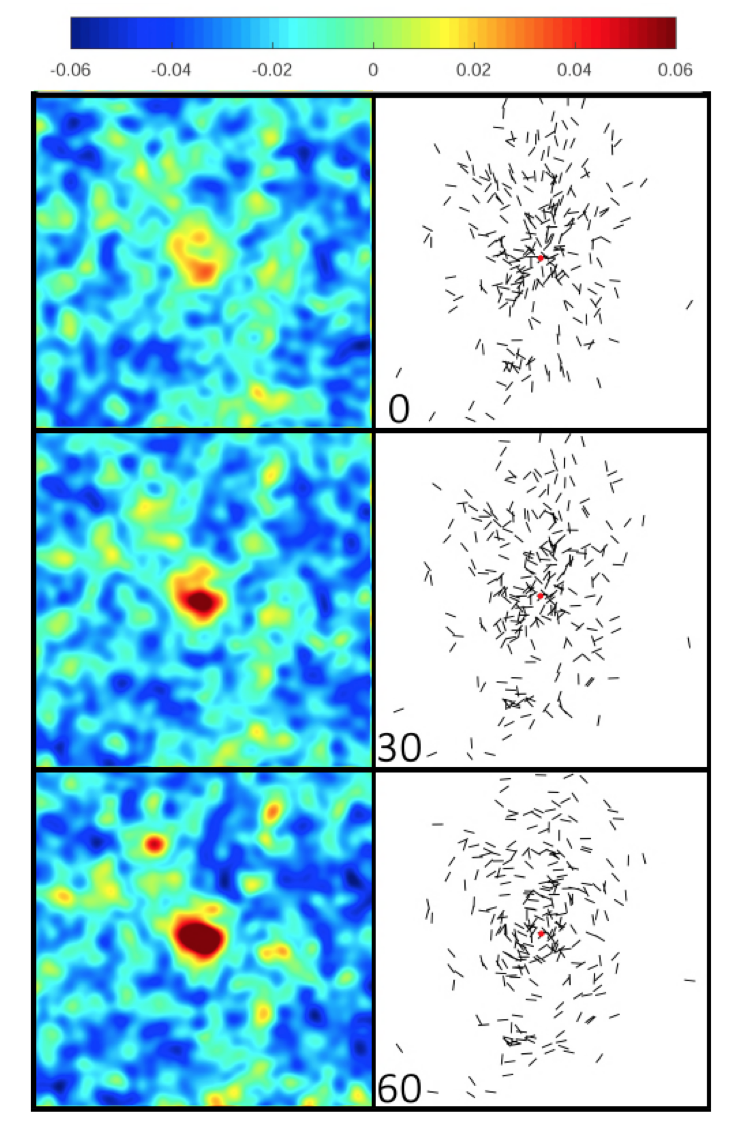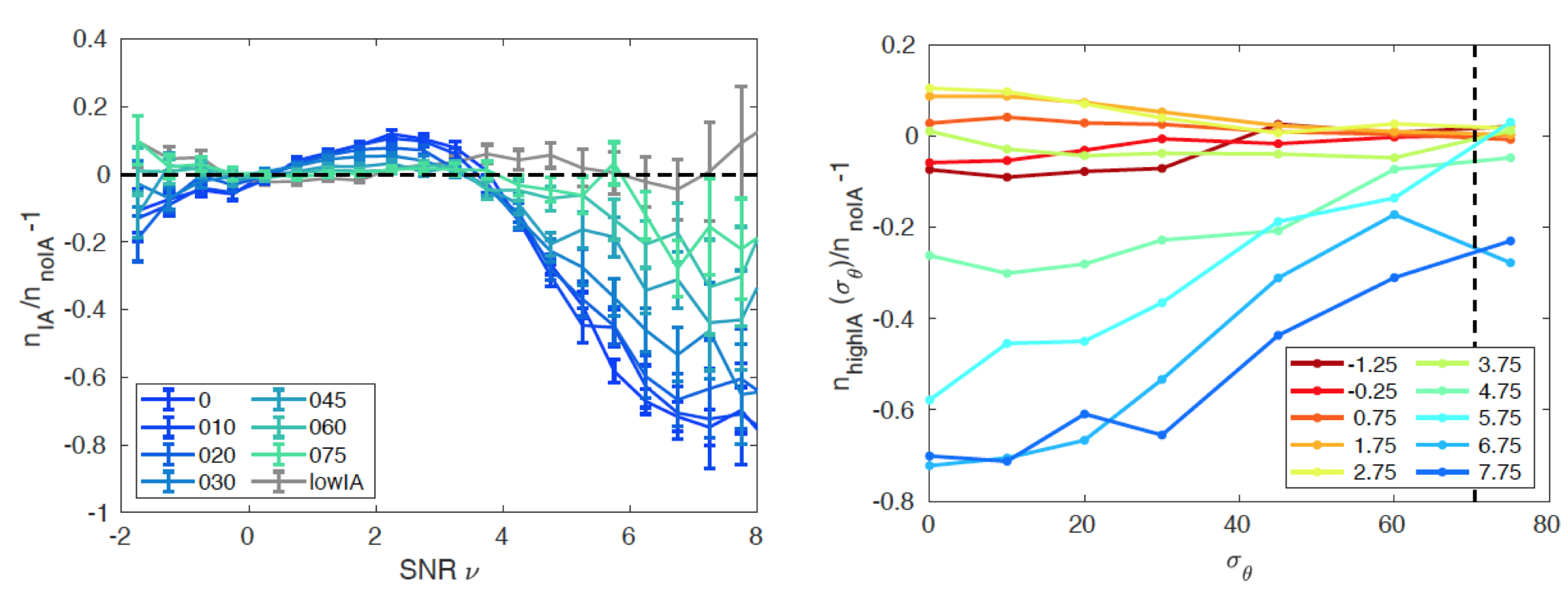中国西南天文研究所宇宙学团组揭示星系内禀指向相关性对弱引力透镜峰值统计的影响
Effects of galaxy intrinsic alignment on weak gravitational lensing peak statistics
随着大型巡天观测的快速发展,弱引力透镜效应已成为研究暗物质、暗能量性质和宇宙大尺度结构的形成与演化的重要探针。为实现高精度宇宙学研究, 需要深入理解各种系统误差的影响。星系内禀指向相关性(IA)与星系形成和演化密切相关,是弱引力透镜宇宙学研究中重要的物理系统误差之一。近日,新利18体育新范祖辉教授带领的宇宙学团组系统地研究了IA对弱引力透镜峰值统计的影响。
利用紫金山天文台合作者运行完成的全天星系模拟数据,该团组构建了具有不同卫星星系IA特征和不同红移分布的剪切样本,据此详细分析了IA对峰值统计的影响。图1显示了不同IA(右)对其宿主星系团弱引力透镜信号的影响(左),可以看出,当卫星星系的IA与径向夹角=0度时,弱引力透镜信号被显著压低,当=60度时,IA信号倾向于切向,与引力透镜信号叠加,造成总信号的增加。图2展示了IA围绕径向=0具有不同弥散时,峰值统计所受影响,其中样本的红移分布与中国空间站巡天望远镜CSST和欧洲Euclid空间项目观测所期待的红移分布相一致。结果显示,对于CSST/Euclid样本, 高峰丰度敏感地依赖于,如不加以考虑,则IA将对宇宙学参数限制带来严重偏差。研究亦指出IA的影响依赖于样本红移分布和平滑尺度,并建立了从无IA的数值模拟构建有IA影响的唯象模型,用以预言IA对峰值统计的影响。
该工作为将IA加入峰值统计建模,从而利用观测的弱引力透镜峰值丰度同时无偏地限制宇宙学参数和IA信号提供了基础。相关文章已被天文学主流国际学术期刊 The Astrophysical Journal接受发表(预印本文库链接https://arxiv.org/abs/2210.06761)。研究所博士生张天宇为文章第一作者,刘项琨副教授和范祖辉教授为共同通讯作者,合作作者包括紫金山天文台和浙江大学合作者。

图1. 卫星星系不同IA对其宿主星系团峰值信号的影响。
Figure 1. Illustration of the impacts of satellite IA on the reconstructed WL convergence signal of their host cluster.

图2. 不同IA对峰值统计的影响(左)和不同高度的峰值受IA的影响随sigma的变化(右)。
Figure 2. The IA effects on WL peak counts.

The fast developments of large photometric surveys have made the weak gravitational lensing (WL) effect become a very important probe in understanding the nature of dark matter and dark energy and the formation of large-scale structures in the Universe. High precision cosmological studies, however, rely on thorough controls of different systematic effects. Among others, the galaxy intrinsic alignment (IA) which is closely related to the formation and evolution of galaxies, is a dominant systematic error in WL cosmology. Recently, a team led by Prof. Zuhui Fan from SWIFAR, YNU, has performed careful analyses about the IA effects on WL peak statistics.
Based on the large simulations with semi-analytical galaxy formation run by colleagues at Purple Mountain Observatory (PMO), Chinese Academy of Sciences, the team has constructed multiple WL mock shear samples with different satellite IA and different redshift distributions to investigate in detail the IA impacts on WL peak abundances. Figure 1 illustrates how the satellite IA can affect the WL convergence signal of their host cluster reconstructed from the observed galaxy shears. Satellites with the radial IA result in a strong suppression of the WL signal of the cluster, while the IA with a tendency of tangential alignment can boost the signal significantly. Figure 2 shows the statistical results considering different dispersions around the radial IA, where the sample redshift distribution matches the expected ones from the upcoming China Space Station Telescope (CSST) and the ESA Euclid space project. It is seen that for CSST/Euclid samples, IA can affect the abundances of peaks, particularly high peaks, considerably, and the impact depends sensitively on the dispersion . Without accounting for the IA effects, the cosmological constraints derived from the observed WL peak counts can be severely biased. The team also analyzed the redshift and smoothing-scale dependences of the IA impacts, and further developed a matching model to obtain the peak counts with IA effects from simulations without IA.
This study provides an important foundation for the future effort to take the IA effects into the theoretical modeling for WL peak statistics. With that, it is possible to derive the unbiased cosmological constraints and the IA information simultaneously from the observed WL peak counts. The paper has been accepted for publication by ApJ. Tianyu Zhang, a SWIFAR Ph.D. student, is the leading author, and Xiangkun Liu and Zuhui Fan are co-corresponding authors. The coauthors also include collaborators from PMO and Zhejiang University.
